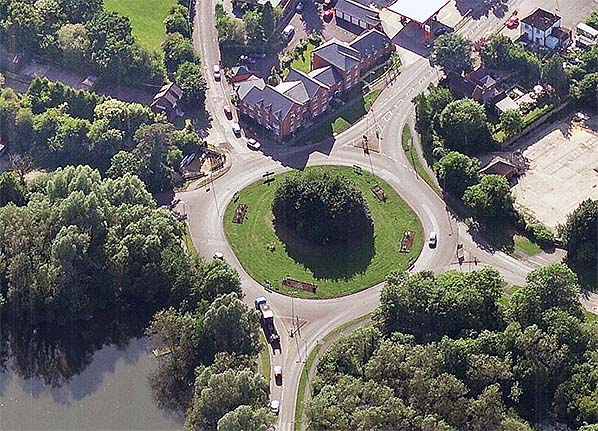
Station Name: BISHOPS WALTHAM[Source:
Nick Catford]
Bishops Waltham Station Gallery 4: 4 c1961 - June 2015
waltham_old34.jpg) The last train is seen shunting at Bishops Waltham station on 27 April 1964. No.41328 was built at the ex-LMS works at Derby in 1952. An Ivatt design, this class 2, 2-6-2 tank lasted until withdrawal from Eastleigh shed on 30 June 1964. It was put into store there until the October, when it was sent for scrapping to Cashmores of Newport and cut up at the end of December. The closure of a station to goods traffic, even when it means complete closure, as at Bishop's Waltham, rarely attracts the large number of enthusiasts that are regularly seen at the closure of a passenger station. Such was the case at Bishops Waltham. Luckily there were at least two enthusiasts there to record the last journey: Richard Casserley, and Dr Roy Coates who recalls the event. ‘Despite the fine warm weather of the preceding few days, the day was cold, very overcast and inclined to drizzle. At about 12.10 pm the train reversed into the down bay (at Botley), propelled by Ivatt Class 2MT No. 41328. The driver collected the token from the signal box, and we set off down the branch with 41328 running bunker-first. The site of Durley Halt was shown us, and two dogs from a nearby farm gave their regular 50-yard chase along the track. At Bishops Waltham shunting took place, while the best use was made of the poor photographic weather. The remarshalled train was left standing in the loop while the crew visited the station, emerging laden with detonators. We departed at 1 pm with a fusillade of detonators from both ends of the train. Instead of slowing to 5mph and hooting vigorously at occupation crossings we came to a dead stop, and proceeded again to the accompaniment of more detonations.’ One photographer is seen on the platform in this view; perhaps it is Dr Coates, caught on film by Richard Casserley.
waltham_old11.jpg) Bishops Waltham station forecourt of 27 April 1964, the last day of goods service. The two storey stationmaster's house is to the right with its entrance in the single-storey block. Presumably the porter who was in charge of the station lived here in later years. The booking office and waiting room on the left was converted into a goods and parcel office in the 1950s. Following the closure to passengers in 1932 the Southern Railway considered letting out the house to a member of the public, but eventually decided against it as they considered it might be difficult finding a tenant. The rear end of a Hants & Dorset bus can be seen on the left. Unfortunately not enough is visible for a positive identification but is it suspected of being one of H&D's Bristol 'L' types, some of which had locally built Portsmouth Aviation bodywork.
Photo by RM Casserley waltham_old19.jpg) This is the only photograph so far found that shows the station after closure. This view was taken in May 1963, a year after closure but before the track was lifted. Apart from the removal of the Southern Railway enamel sign on the side wall of the gents' toilet little else appears to have changed. Two years later this would all change when the station was demolished prior to the construction of a roundabout on the site of the station with a new town bypass running along the length of the goods yard; this was completed in 1971. Coal Merchant A E Smith was able to stay in business and the 1971 OS map shows a coal yard on the west side of the new road junction; by 1983 the site is identified as a 'depot' .
Photo by Ben Brooksbank waltham1.jpg) Looking north-east from the site of Bishops Waltham station in June 2015. Corhampton Lane, straight ahead, follows the course of the railway from the station towards the goods shed.
Photo by Nick Catford waltham2.jpg) South of the Old Station Roundabout 300yd of the old trackbed has been retained as a public footpath and now forms part of the Pilgrims' Trail footpath which was created by the Bishops Waltham Society and now forms part of a 155-mile long-distance footpath that connects Winchester Cathedral to Mont St-Michel in Normandy.
Photo by Nick Catford 
The site of Bishops Waltham station seen from the air. The level crossing gate seen above can just be made out to the left of the roundabout. Winchester Road runs from the top right, across the roundabout and into the right of Bishops Waltham Pond which is seen bottom left. The road running off top the right is Corhampton Lane which follows the course of the goods yard. The open ground to the right is the site of the coal yard. An aerial photo from 2014 shows that this is now housing.
Click on thumbnail to enlarge
|
waltham_old27.jpg)
waltham_old35.jpg)
waltham_old39.jpg)
waltham_old44.jpg)
waltham_old32.jpg)
waltham_old33.jpg)
waltham_old_thumb13.jpg)
waltham_old_thumb41.jpg)
waltham_thumb3.jpg)

 Home Page
Home Page